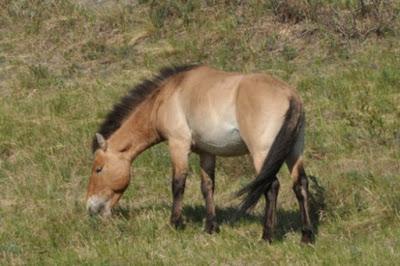
Przewalski horse, Mongolia
My friend and fellow children’s book writer Caroline Hatton visited Mongolia in June of 2015. Caroline has always been fascinated with horses and shares here a memorable experience she had with the rare Przewalski horses in Hustai National Park. To find out more about Caroline and her books, visit her website, www.carolinehatton.com . She took all the photos in this post, except for the one in which she appears, which was taken by her husband Bill.Freeze. Nathalie’s silent body language was clear. As an eco-volunteer recording observations for the wild horse scientists of Hustai National Park in Mongolia, she knew how to follow the animals without disturbing them. Across the gully, a small horse, who looked like a live prehistoric cave painting, grazed peacefully.
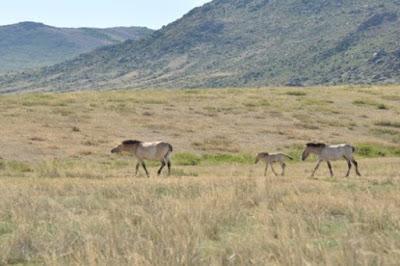
Przewalski horses in the wild
This was no ordinary horse. It is called takhi in Mongolian (pronounced ta-chee with the ch as in the Scottish loch), Przewalski (pronounced prez-vahl-ski or sheh-val-ski) horse in English, and its scientific name is Equus przewalskii. It belongs to the same genus as the domesticated horse, Equus caballus, but it is a different species.The takhi are small horses. Average adult size is 135 cm (more than 13 hands, or 4 feet 5 inches) at the withers (the point between the neck and back).The takhi once roamed the steppes of Central Asia in large numbers. It became extinct in the wild in the 1960s. But thanks to tremendous international efforts, it was re-introduced in 1992-2000, at sites including Hustai National Park, located roughly 100 km (62 miles) southwest of the Mongolian capital, Ulaanbaatar.
Although the takhiexisted only in captivity for thirteen generations, it has never been domesticated. This makes it the only true living wild horse. In contrast, the American Mustang, a descendant of domesticated ancestors, is technically not wild, but feral.
As we watched the horses, Nathalie wrote down her GPS coordinates, the temperature, wind speed, and main activity of the band: grazing.
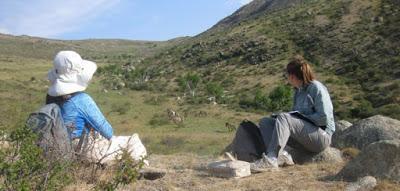
Caroline Hatton (left), takhi, and eco-volunteer
The takhi’s social life and behaviors are essentially the same as those of free-roaming Equus caballus such as “wild” Mustangs. Nathalie and I exchanged smiles when a foal took a peek at us, then suckled a few sips.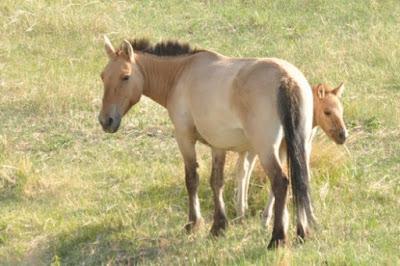
Mare and foal
The other mares and youngsters in the band grazed as they strolled uphill. The stallion brought up the rear. To drive one of his harem members, he “snaked” her by lowering his head, with his ears laid back.The mare ran along well before the snaking stallion got near her.
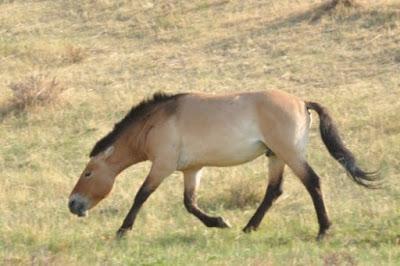
Stallion “snaking" to herd a mare
Nathalie stood up when the takhi moved out of sight, up the gully. She followed them quietly at a distance. Every ten minutes, she filled out one line on her data form.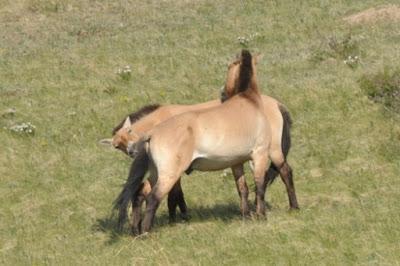
Mutual grooming between friends
The band of takhi now stood below the top of the mountain, resting. Nathalie’s anemometer whirred as the wind rose. The temperature dropped even in full sun.At eleven thirty, we ran down the mountain to meet the park minivan on the dirt road for our ride back to camp at noon. My husband and I thanked Nathalie and her boss, Nara, a park biologist, for letting us accompany Nathalie all morning.
While at the park, my husband and I stayed in our own ger [the Mongolian word for a yurt] at the Hustai Tourist Resort (camp) and enjoyed the simple, tasty food at the camp restaurant. We hiked along gullies, up the low mountains, through steppe grasses and birch forest. Of the estimated 40,000 resident marmots, we saw an average of 14 per day.We also spotted deer, squirrels, a hare, a gray fox, magpies, steppe eagles, and demoiselle cranes. We did not take advantage of the available domesticated-horse rides or visits to local nomads.
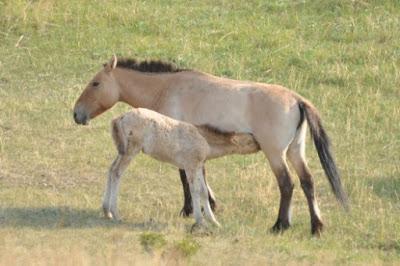
Foal nursing
Even when the takhi had gone extinct in the wild, it had remained alive in the hearts of the Mongolian people. Seeing takhiroam free in its homeland again was a moving experience.For more on Hustai National Park (also spelled Khustain), visit http://www.hustai.mn. To arrange a car ride from Ulaanbaatar to visit and reserve lodging, e-mail [email protected].
Watch the video, Hustai National Park part 1 of 2 (8 minutes) at https://www.youtube.com/watch?v=qkkaRe6u4C0.
Watch the video, Hustai National Park part 2 of 2 (9 minutes, including takhi info) at https://www.youtube.com/watch?v=YgKbZhq5ChY
Watch the video, Hustai National Park’s ecovolunteer program (5 minutes) at https://www.youtube.com/watch?v=7AdA-bGHc7c
For information on takhi, visit http://www.treemail.nl/takh
